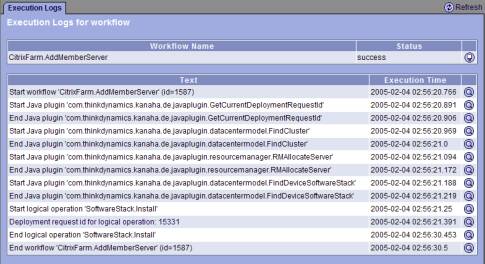| Tool Mentor: TPM - Perform Deployment Management |
 |
|
| Related Elements |
|---|
ContextTool mentors explain how a tool can perform tasks, which are part of ITUP processes and activities. The tasks are listed as Related Elements in the Relationships section. You can see the details of how processes and activities are supported by this tool mentor, by clicking the links next to the icons: DetailsThe IBM® Tivoli® Provisioning Manager contains a component called the deployment engine, which is ultimately responsible for workflow executions that have a direct impact towards change within an infrastructure. Release Packages are deployed using the workflow functionality within Tivoli Provisioning Manager. Usually in the form of software products, Release Packages can have a wide variety of configuration parameters that are configured at workflow runtime. The parameters are harvested at runtime from multiple possible sources including workflow parameters that are passed at runtime, or parameters that are encapsulated within the DCM information that describes the datacenter environment.
Following successful execution of workflows, the data center model is updated to reflect any changes to infrastructure items that can include inventory lists against a specific server instance. For example, a workflow might deploy an instance of a software package against a server within the datacenter. Following the successful execution of the Software.Install workflow against this device, the inventory of the server would receive an update to reflect the additional software that is now located on that resource. With advanced features such as conditionals, looping, and branching, workflows have a very powerful capability to provision software elements, configuration parameters, or re-configure items within the datacenter. In addition to executing a workflow manually to deploy a release, workflows might be executed automatically based on an existing condition, or as part of a larger overall workflow process routine, such as the addition of a server into a cluster, for example. Workflows provide administrators with the flexibility to customize their deployment operations in a wide variety of implementations. Examples of the real value that workflows provide, along with samples of various software product standards that are supported can be located on the IBM Service Management workflows Web page located at http://catalog.lotus.com/wps/portal/tpm. There you will find information such as:
The open nature of workflows by their design allow for very simple integration into a wide variety of third-party solutions (including products from companies other than IBM). Should your organization include products to carry out specific aspects of release rollout, Tivoli Provisioning Manager workflows can easily integrate and utilize a wide variety of toolsets. By integrating these tools into your release deployment process, your IT organizations will be able to significantly reduce costs they might otherwise spend on additional tools and training. An online catalog of release deployment workflows, providing functionality into a wide variety of industry-standard products is available through the IBM Open Process Automation Library. You can access this library online at http://catalog.lotus.com/wps/portal/tpm. For More InformationFor more information about this tool, click on the link for this tool at the top of this page. |
©Copyright IBM Corp. 2005, 2008. All Rights Reserved. |
